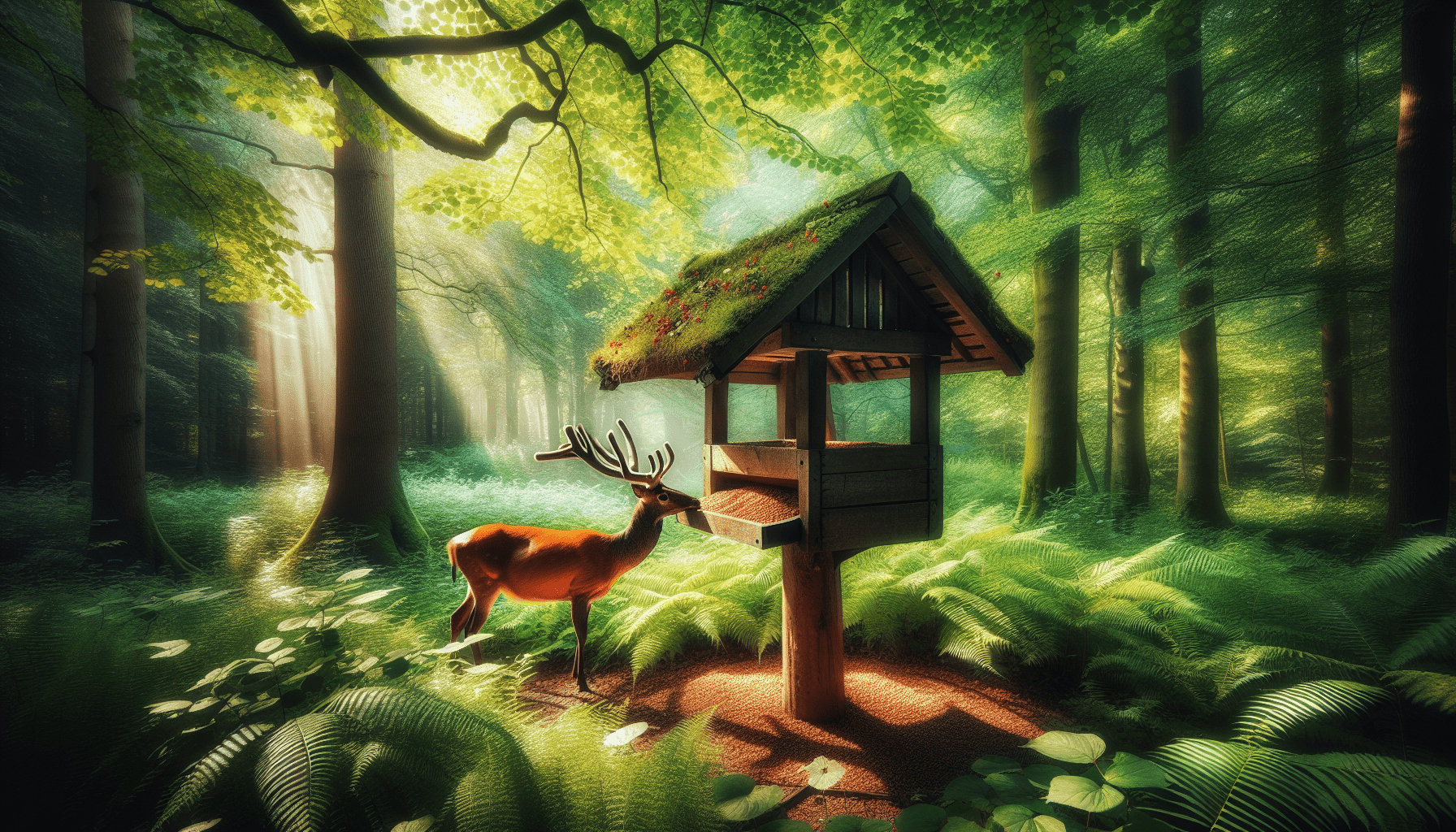
What role do you think feeding strategies play in the health and vitality of wildlife, especially deer?

Understanding Wildlife Health
Wildlife health encompasses the physical and mental well-being of animals living in their natural habitats. This is crucial not only for individual species but also for ecosystem balance. Healthy wildlife contributes to biodiversity, which in turn supports the environment by maintaining healthy soil, water, and plant life. With proper management, populations can thrive and contribute positively to their surroundings.
The Importance of Deer as a Keystone Species
Deer are often referred to as a keystone species, meaning their presence significantly impacts their environment. The role they play extends beyond their populations to include influencing vegetation dynamics and serving as prey for larger predators. By maintaining healthy deer populations, you can help ensure a balanced ecosystem, benefiting other wildlife and plant species in the area.
Factors Influencing Deer Health
The health of deer is affected by several factors including habitat quality, food availability, genetic diversity, and disease prevalence. Each of these elements plays a crucial role in determining whether deer populations can thrive in a given area. Understanding these factors is the first step toward improving wildlife health through strategic feeding.
Habitat Quality and Its Relation to Deer Feeding
Deer flourish in habitats that provide ample food, cover, and space for movement. When these elements are lacking, their health can decline. The importance of feeding becomes particularly apparent in areas where natural food sources are insufficient to meet the nutritional needs of deer.
Natural Food Sources for Deer
Most deer species are herbivores and rely on a variety of plants for nutrition. Their diets typically include:
- Grasses
- Herbs
- Leaves
- Fruits
- Nuts
During different seasons, the availability of these food sources fluctuates. During winter months, for example, it may become difficult for deer to find adequate nutrition. That’s where strategic feeding can play a vital role in maintaining their health.
Habitat Assessment for Effective Deer Feeding
Before implementing a feeding strategy, you can assess the habitat to understand the current conditions. This includes evaluating:
- Vegetation Types: Identify the abundance and distribution of preferred food items.
- Water Sources: Ensure activities are close to water, as deer need it to survive.
- Cover: Evaluate whether there are adequate hiding spots to protect deer from predators.
Creating an ideal habitat will not only benefit deer but also other wildlife sharing the space.
The Seasonal Cycle and Deer Nutrition
Deer face unique nutritional challenges as seasons change. Understanding these cycles can help in planning feeding strategies.
Spring and Summer
During spring and summer, deer require high-protein forage to support growth and lactation. While natural food sources should be plentiful, supplemental feeding may still be necessary in areas where food is scarce due to overpopulation or habitat degradation.
Fall and Winter
As winter approaches, deer need energy-rich food to survive harsh conditions. This is a critical time for feeding strategies because harsh weather can limit access to natural food and exacerbate food scarcity.
Crafting a Strategic Feeding Plan
When it comes to enhancing wildlife health through strategic deer feeding, a well-thought-out plan is essential.
Establishing Objectives
Before you start, it’s important to clearly define your goals:
- Population Management: Are you trying to increase or stabilize deer populations?
- Nutritional Balance: Do you want to fortify a specific nutrient that’s lacking in their diet?
- Habitat Restoration: Are you working to rehabilitate a degraded area?
Choosing the Right Location
Selecting the right locations for feeding stations can enhance effectiveness. Consider:
- Proximity to Water Sources: Ensure feeding stations are not too far from water.
- Covering: Orient feeding stations in areas with natural cover to make deer feel safe.
- Accessibility: Ensure that the sites are easily accessible for both deer and yourself for management purposes.
Types of Feed
Selecting the appropriate type of feed is critical. Options include:
| Feed Type | Description | Benefits |
|---|---|---|
| Whole Grains | Maize, oats, or barley | High-energy staple diet. |
| Nutritional Blocks | Mineral and vitamin-rich cubes | Provide essential nutrients needed for health. |
| Pellets | Compressed feed mixtures | Convenient and can be formulated for specific needs. |
| Natural Browsing | Allow natural forage to regrow | Supports the ecosystem and diet diversity. |
Each type of feed has its advantages and disadvantages. You can experiment with different mixtures or types to determine what works best in your area.
Maintaining Cleanliness at Feeding Stations
To keep deer healthy, cleanliness at feeding sites is essential. Contaminated feed or the spread of diseases can lead to significant health issues. Regularly monitor feeding stations for cleanliness by:
- Regularly Replacing Feed: Remove old feed that may attract pests or lead to spoilage.
- Cleaning Feeding Equipment: Use solutions that disinfect without harming the animals.
- Monitoring Deer Health: Keep an eye on deer that frequent the area to catch any signs of illness.
The Role of Nutrition in Deer Health
Understanding the nutritional needs of deer is fundamental in crafting an effective feeding strategy.
Crucial Nutrients for Deer
Deer, like all animals, require a balanced diet that includes:
- Proteins: Important for growth and reproduction.
- Carbohydrates: Provide energy necessary for daily activities.
- Fats: Vital for overall health and energy reserves.
- Minerals: Support bone health and reproductive performance.
- Vitamins: Essential for metabolic processes.
Nutritional Deficiencies
If deer are not receiving these critical nutrients, they may experience severe health issues. Symptoms could include:
- Lack of energy
- Poor body condition
- Difficulty reproducing
- Increased vulnerability to diseases
By addressing potential deficiencies through strategic feeding, you can help improve the health of deer populations.
Monitoring Deer Body Condition
One effective way to assess the success of your feeding strategy is by monitoring the body condition of deer:
- Visual Assessments: Regularly observe the overall health and size of the deer population.
- Weight Checks: If possible, weigh deer to monitor changes throughout the seasons.
- Health Surveys: Collaborate with wildlife professionals to perform health assessments.
These methods will provide insight into how well your feeding strategy is supporting deer health.

Legal and Ethical Considerations in Deer Feeding
Before implementing any feeding strategy, it’s important to be aware of legal and ethical frameworks in your region.
Local Regulations on Feeding Wildlife
Laws and regulations concerning wildlife feeding vary by location and can include:
- Permits: Some regions require permits for feeding wildlife.
- Feeding Restrictions: Limitations on the type or amount of feed that can be provided may exist.
- Hunting Regulations: Regulations may outline how feeding impacts hunting seasons and practices.
You can consult local wildlife management authorities to gain insight into these regulations.
Ethical Feeding Practices
Feeding wildlife also raises ethical considerations. To ensure that your strategy is both humane and environmentally responsible, consider:
- Natural Behavior: Avoid interfering with natural foraging habits of deer.
- Habitat Degradation: Use feeding as a supplemental resource rather than a primary food source to prevent dependency.
- Health Risks: Be aware of the potential for disease transmission among concentrated groups of deer at feeding sites.
Community Involvement in Enhancing Wildlife Health
Engaging your community can create a supportive network for improving wildlife health.
Educating the Public
Raise awareness on the importance of wildlife health and how strategic deer feeding can play a role. You might host workshops or create informational materials to share with fellow community members.
Collaborating with Local Agencies
Local wildlife agencies and nonprofit organizations can offer assistance in creating feeding strategies. They often have valuable resources, knowledge, and experience that can enhance your efforts.
Involving Local Schools
Initiating educational programs in local schools can foster a sense of responsibility among younger generations. Activities could include:
- Field Trips: Organize visits to wildlife management areas.
- Projects: Engage students in research projects on local wildlife health and ecosystems.
Creating awareness and responsibility among community members ensures a sustainable approach to wildlife health beyond the feeding strategy.
Long-term Strategies for Wildlife Health
Enhancing wildlife health, including strategic deer feeding, is not a one-time act. To create lasting change, consider implementing long-term strategies.
Continuous Monitoring and Assessment
Establish ongoing monitoring of deer populations and health conditions. Regular assessments allow you to adjust your feeding strategies based on actual needs and conditions.
Adaptive Management Techniques
Wildlife management should be adaptive, meaning you take feedback and changing conditions into account. Monitor factors such as population dynamics, habitat changes, and environmental conditions. Use this information to evolve your feeding strategies as necessary.
Research and Development
Staying informed about new research developments in wildlife management can significantly impact your strategies. This may include advances in nutritional science, population modeling, and disease management.
Conclusion: A Shared Responsibility
Strategic deer feeding is not only a valuable tool in enhancing wildlife health but also a responsibility that we all share. By understanding the complexities of deer populations, habitat quality, and nutritional needs, you contribute positively to wildlife conservation efforts. Through community engagement, education, and ethical practices, you can create an environment where both deer and ecosystems thrive. In the end, your efforts today can lead to healthier wildlife and a more robust future for our natural world.





